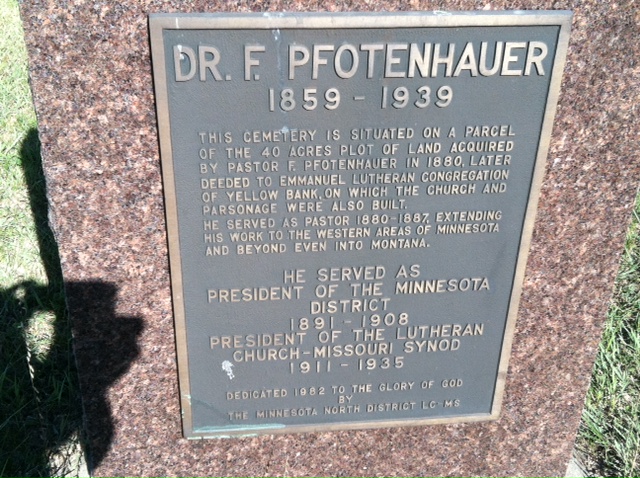Pfotenhauer was installed on Nov 7, 1880 in a small house near this area. The members of his “church” kept the edges of this 40 acre tract of land that he would come to own black to keep him from being killed in the frequent prairie fires that ravaged the area. His installation took place in a one room shack and he knelt on a home made chair that served as an altar. No records exist that he wore a chasuble or who the “cantor” was. Pfotenhauer not only preached around Millbank and Odessa SD, but he went into the James River valley on North Dakota and all the way to Bozeman Montana and wherever he went he established “preaching stations”. His brother Albert and he served one of the preaching stations at Hannover North Dakota in 1886. Records from those days talk about the service being conducted in one to three room homes while sauerkraut was being cooked over a wood stove in what some would call a kitchen. No mention is made of pipe organs or Gospel processions with crucifixes. If sauerkraut cooking can be descirbed as incense then I guess they had some.
I can count at least 22 preaching stations that became congregations because of the direct work of Fredrick Pfotenhauer who became President of the Lutheran Church Missouri Synod. Yesterday I heard that the beneficiaries of his work and descendants of his toil reported that they preferred no visitors to the worship they conducted on Sunday mornings because “the Divine Service is meant only for LCMS members in good standing”. The whirring sound that you hear may be Fredrick turning in his grave. Records tell us that looked for Germans in the cast plains that were his charge so that he could gather them into congregations, but there are no records that anyone else was excluded. If you could understand German you could come to the preaching, and questions about communion are seldom raised. In fact Pfotenhauer’s own words to the Mission Board, “dakota must become Lutheran” may prove that the preaching stations were to be not only for the faithful Lutherans but also for the pagans. Reading the old records all one sees is references to “preaching” and send us more “preachers” Never a word about “liturgists”.
I had a discussion concerning an individual that assiduously worked at the liturgy and felt that everything must be done exactly right and at the right time. Hands lifted at the right time, sign of the cross made at the right time, not to late or too early. Turn to the congregation and back to altar at the right time and in the right direct etc etc etc. When it came to the sermon however communication actually seemed to a secondary consideration and getting through 12 minutes of a dense exposition of a text seemed to be the goal. Whether anyone was listening or could understand was not important. Luther talked about the centrality of preaching and that the “publically echoing voice of the Gospel” was essential and primarily. I remember sitting in on a meeting of a group of Pastors that spent 1/2 an hour arguing about whether we were to turn to the right as we moved from facing the congregation and truning to the altar. Which was more liturgically correct. The phrase “who cares?” was banging in my head but it was obvious that they did!
This from President’s Harrison’s blog – Mercy Journeys
We are today given the impression that worship in the ancient church was quite exclusively liturgical — as we still find it, for example, in Eastern Orthodox churches. But in a sermon one of the ancient Church Fathers sets forth in very vivid fashion the fault he has to find with the contemporary liturgical service. The congregation is not there, he reports. The people are wandering about outside, the boys and girls lounging about during the performance of the liturgy. They have a watchman posted at the door, however, and when the distribution of the elements in Holy Communion is about to begin, a signal is given and the young people rush into the church like a pack of hounds, snatch up the host from the clergyman’s hands as a dog snatches up a piece of meat, and then depart. I am not suggesting that this sort of thing was the general practice, but it happened. –
Sermons were not dull doctrinal addresses in our sense of the term. Congregations were attentive. Records reveal the tremendous, dramatic emotion which the sermons evoked, even the cries with which the auditors interrupted the preacher. The stenographic reports give us all sorts of information, even that Augustine had a bad cough on one occasion. This is alluded to in a passing remark, ‘Pardon me, I could not help coughing, for I have been preaching a great deal the last few days.’
“If one reads the great sermons on the dogma of the ancient church which Gregory Nazianzen preached in Constantinople before he was elevated to the patriarchate—the entire dogma of the ancient church is contained in four sermons which have been published on the basis of stenographic reports— one must be astonished at the intellectual and spiritual power of the preacher, who was able to communicate the teaching of the church to his hearers in such a compact, vivid, and existential manner, for what he treated concerned life and death. This is what services were like in the ancient church. Our honored liturgiologists . . . will say that all of this is well known. But there is still danger that we misinterpret the ancient church when we see it only in the light of the Benedictine investigations and inquire only about the origin of the Kyrie and ask when the Hallelujah was first employed. . . .“The impression has gone abroad, and our liturgiologists are at least partly to blame for this, that the preaching, teaching church is to be replaced in some sense by the liturgical church. – Werner Elert



Excellent point! There is a great need for confessionally solid Lutheran preachers who proclaim Law and Gospel. Litugry is great! But Paul’s question in Romans 10 is still valid, and possibly haunting, “How shall they believe in the one of whom they have not heard?”